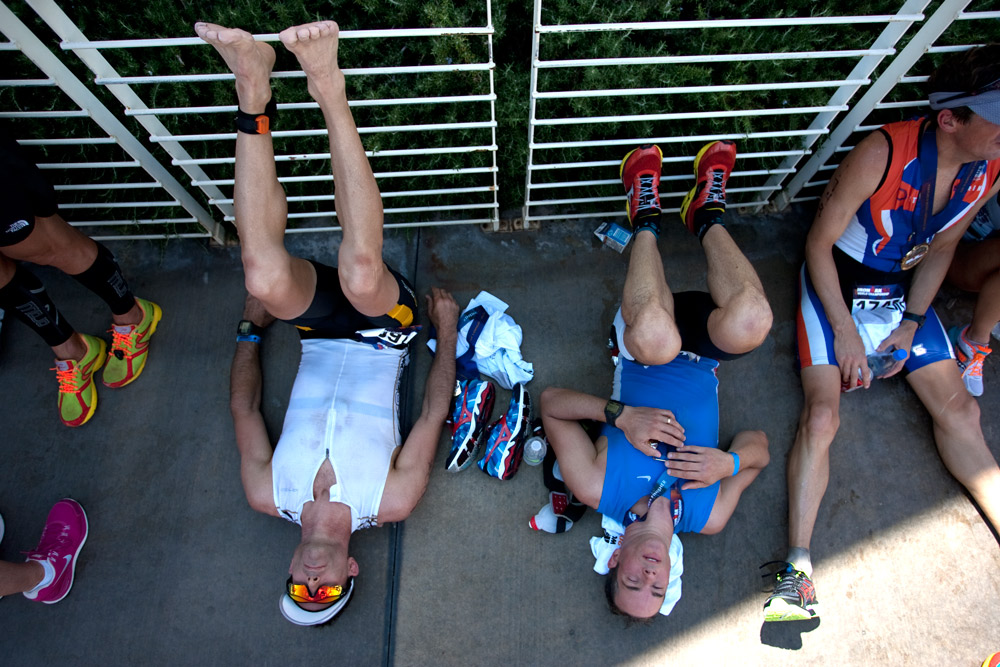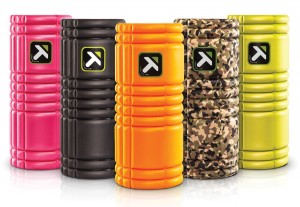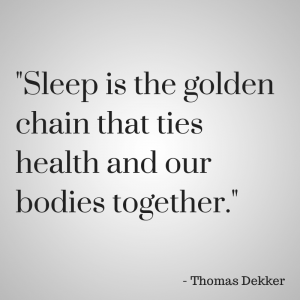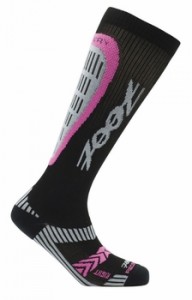
By Sarah Lieneke-Nickle
So you’re a triathlete. And you train. Maybe you train a lot. Maybe you’ve even hired someone who knows more than you about training to tell you what to do so you can go faster. Great, now you know when and how far to swim/bike/run each day. But what you do in between may be nearly as important as what you do in each specific sport if you are injury-prone, as I seem to be.
You see, I didn’t always pay attention to the in-between. I would swim/bike/run my heart out, come home, plop on the floor until I stopped sweating while drinking my recovery drink, then hit the shower and carry on with life. And it was great, I got fast! And then… I got injured (before you assume this was from overtraining – it wasn’t, I pulled/strained/tore something that has never properly healed, but that is beside the point). I’m telling you this because after 4+ years of treatment, I’ve come to the realization that the way I spend my in-between time is crucial to being able to even think about training. Hopefully through sharing, I can help someone else avoid the dreaded injury cycle. I’m not a doctor, though I’ve seen over a dozen health-care practitioners in my quest to beat this thing once and for all. I’m coming close (fingers crossed) to starting to think about racing again because I’ve dedicated myself to making smart choices for how I spend my time between workouts.
Tip #1: Your foam roller is your friend, not your foe. Confession: I did not know how to use a foam roller until I was well into my triathlon career. At physical therapy one day, the PT told me to “get warmed up over on the foam roller.” Hoping no one would notice I didn’t know what I was doing, I wiggled around on it, relying on intuition that told me “just roll back and forth.” A few years later, another therapist suggested I get one for use at home, so I headed out and picked up a big, white, soft foam roller. I found this very useful – for keeping the dog off the couch. Frankly, I didn’t see what the fuss was about, as it never really made me feel different. It wasn’t until I was properly introduced to the TriggerPoint products that I really “got it” and felt a difference in my body after a proper rollout session. The beauty is that it really doesn’t take long – 15, maybe 30 minutes a day. But, just like with your other training, consistency is key. Wait until something feels like it needs addressing and you’ve waited too long. I use both the GRID® foam roller and the Ultimate 6 Kit, plus I have a GRID® Mini that I take with me when I travel. Why do I use these over my big, white roller? They’re firm so they really get the job done. I don’t have 15-30 minutes to waste, so I choose my tools carefully.

Tip #2: Hydrate. We all know how important hydration is when it comes to performance. Sports drink companies have spent millions in research and marketing so we never forget that a tiny drop in hydration levels can wreak havoc on our performance. What I didn’t know is how important round the clock hydration is for muscle elasticity. As someone who is trying to keep my body un-locked through frequent rolling, I have been known to not maintain proper hydration levels. But come on…water is so…boring! A few tricks I use to drink more include keeping flavored hydration tablets handy (NUUN and Hammer Endurolytes are currently in the cabinet) but I also love making fruit or herb infused waters. It is so simple and a great pick-me-up when you’re feeling the mid-day slump.
Infused Water Recipe
20 oz water
1/2 orange, sliced
1/2 lemon, sliced
3-4 basil leaves, torn
Directions: Combine water and fruit overnight in the refrigerator. I like to use a mason jar with a lid to keep any potential fridge odor out. Strain in the morning and enjoy! Can be made with any fruit and/or herb combo that suits your palate.
Tip #3: Sleep. Intertwined with my chronic injury, I am also a recovering insomniac. Born from a particularly stressful time in my life, insomnia plagued me for close to 5 years and in turn, did a number on my health and well-being. My workouts suffered, my recovery suffered, not to mention I was not very fun to be around from being constantly tired. Thankfully my insomnia seems to have been situational, though occasionally it does rear its ugly head. Now I pay far more attention to my sleep/wake cycle than I ever have. Had a bad night’s sleep? I’ll skip my morning workout for a few extra zzz’s, knowing that skimping on sleep will snowball on me if I’m not careful. Interestingly, I find that foam rolling right before bed helps relax me to prepare for a good night’s rest.

Tip #4: Keep Moving. Unfortunately, I have a job where I sit on my computer most of the day. Fortunately, my laptop can move around with me so I try to mix it up by standing some and sitting some. Why? Sitting for long periods of time, day after day, is bad for your body. The fixed position, bad posture and inactivity are a recipe for disaster down the road (read tight hip flexors, shoulders, lowered energy levels.) Since I want to keep myself as “well oiled” as possible, I like to mix it up between sitting and standing at my desk. If you don’t have an adjustable height desk, set an alarm to remind yourself to take 5 minutes an hour to get out of your chair and simply move. Consider this part of your training if it helps you take it seriously. On the other hand, if you have a job where you stand much of the day, I absolutely recommend wearing compression socks and taking breaks to sit. Feel free to do your own experiment by wearing compression socks one day and not the next. Notice a difference?

Tip #5: Don’t ignore your gear. So maybe you’ve taken some time off, or you’re only running a few times a week. Do you know how many miles are on those running shoes? What about the tires on your bike? Are they worn and cracked? Have you cleaned your chain recently (or ever?) Your body isn’t the only thing you should be taken care of in the in-between time. You’re right, I haven’t heard of anyone getting injured from a dirty bicycle chain, but what if that cracked tire blows when you’re headed downhill at 30mph? And you know better than to run in shoes with too many miles on them, yet I bet you’ve done it. Sooner or later, ignoring your gear is going to catch up with you. Don’t let it!
Hopefully you’ve been able to pick up a nugget or 2 to focus on in the in-between. My best to you for happy and healthy training and racing!
About Sarah Lieneke-Nickle: Sarah is a 13-year veteran of the sport and built her first triathlon bike in the original TriSports.com warehouse – the garage of Seton and Debbie Claggett. A graduate of the University of Arizona school of Architecture, her passion for racing led her away from licensed practice in favor of working “in the industry.” Despite battling a chronic hip injury for the past 4+ years, Sarah earned her pro card in October 2012. She hopes to resume racing this fall. Keep up with her triathlon (mis)adventures on Twitter at @sarahlieneke.
